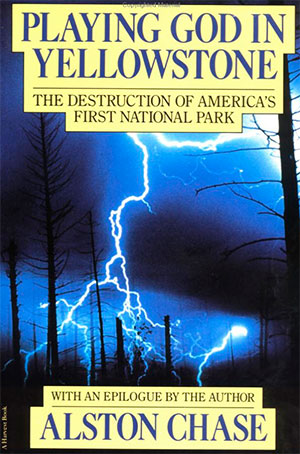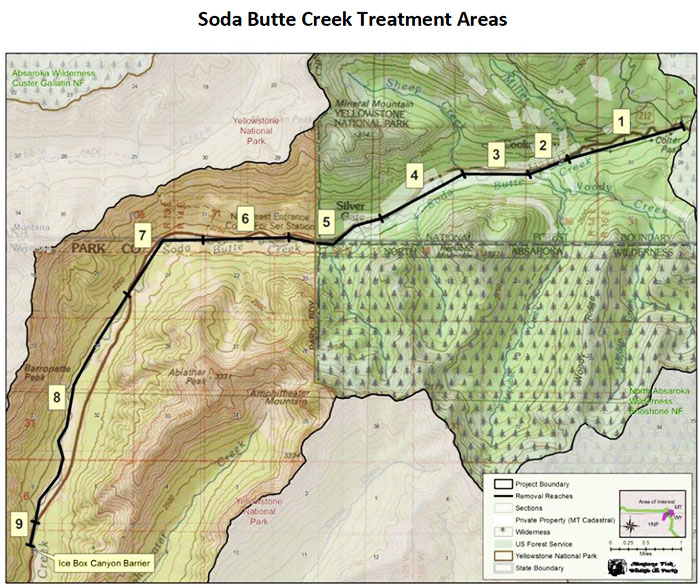Roughly half of the public comment period has already passed regarding the pending Soda Butte Creek Native Fish Restoration Project, part of Yellowstone’s grand Native Fish Conservation Plan (link below).
As always there are several layers to the story.
About That (Probably Unfair) Literary Reference
 Back in 1987 Alston Chase wrote Playing God in Yellowstone: The Destruction of America’s First National Park (with an Epilogue by the Author). Our copy still sits on the shelf, and while it’s a bit outdated at this point there are those who agree with many of the stinging critiques Chase levied back in the day. (Personally, Chase’s characterization of YNP didn’t -and still doesn’t- fit with my personal perceptions of Yellowstone; I didn’t savor the read.)
Back in 1987 Alston Chase wrote Playing God in Yellowstone: The Destruction of America’s First National Park (with an Epilogue by the Author). Our copy still sits on the shelf, and while it’s a bit outdated at this point there are those who agree with many of the stinging critiques Chase levied back in the day. (Personally, Chase’s characterization of YNP didn’t -and still doesn’t- fit with my personal perceptions of Yellowstone; I didn’t savor the read.)
One common misperception of Chase’s book is that it’s some sort of historical treatise on YNP; it’s not, it’s much more of a presentation of AC’s personal view of Yellowstone and the Park Service, particularly its bureaucracy. And clearly hard science the book is not.
For those who would like to delve into a bit more objective history, consider digging up a copy of Paul Schullery’s Searching for Yellowstone.
As to the playing god reference, ‘treating’ a living, breathing, fish-filled stream with Rotenone, even with the best of intentions and documented successes, still gives me pause every time I ponder it.
Like many fly fishers before me, I’ve gone to extreme (some might say insane when viewed in the realm of everyday 2015 realities) to protect fish and fisheries, donating time, hard-earned cash and sweat equity to improve habitats, fight habitat degradation, support native species, etc.
Let’s face it, killing established albeit non-native fish in a pristine YNP fishery, almost always seems counterintuitive at first blush. But, as is most often the case, there’s more to the story.
About the Soda Butte Plan
One thing we’ve learned over the years is that fisheries biology and management is, when you get right down to it, a pretty damned complicated science that can never truly be boiled down to a simple ‘A versus B’ decision. (People who try to tell you it’s as simple as an ‘A versus B’ decision are lying to you and have some sort of agenda they’re otherwise pushing.)
For example you can’t eradicate a single target species with Rotenone and not touch the entire stream or river ecosystem to one degree or another; those pansystem effects might be transient, but they’re real.

As part of Soda Butte Creek lies outside of YNP in Montana and Wyoming, Montana’s FWP (Fish, Wildlife and Parks) and Wyoming’s sister agency has been working on the issue of non-native brook trout and hybridized cutthroat trout in conjunction with YNP teams for nigh on a decade. Electrofishing and other methods have failed.
The bottom-line concern is this – the non-native brook trout fairly easily displace Yellowstone cutthroat, are slowly working deeper and deeper into the Park and at some point, will significantly threaten the native cutthroat fishery in the Lamar watershed.
This article in the Jackson Hole News and Guide – Study Calls for Killing Soda Butte’s Brookies – shares the nitty gritty on stream mileage to be poisoned (38 miles), where those miles actually lie in relation to Park and state borders, etc.
For those interested, here are a few more project related links –
Yellowstone’s Native Fish Conservation Plan
Document List for Soda Butte Creek Native Fish Restoration Project
About that (Bastard) Rotenone
Many Montanans are quick to condemn Rotenone given the fairly recent history (2010) with Cherry Creek, a tributary of the Madison; search ‘cherry creek rotenone incident’ if you don’t know the story.
A guide friend sent me to this article last year – When Poisoning is the Solution – in High Country News (typically hardly a bastion of scientific objectivity) by none other than Ted Williams. An excerpt –
Cutthroat trout subspecies of the Interior West are being hybridized off the planet by rainbow trout from the Pacific Northwest, dumped into their habitat during the age of ecological illiteracy, which ended circa 1970.
In most cases, the only hope for the natives is rotenone, a short-lived, easily neutralized, organic poison rendered from tropical plants.
But a war on rotenone has been declared by chemophobic environmentalists, who refuse to learn about it, and by anglers who don’t care what’s on the other end of the rod so long as it’s bent. Although rotenone is essential to management as defined by the Wilderness Act, the group Wilderness Watch, for example, asserts that “poison has no place in wilderness…”
…State and federal fisheries managers are mandated by the Endangered Species Act to save the natives by poisoning the aliens. For years, however, this work has been impeded by individuals, publications and organizations that concoct and recycle horror stories about rotenone. Apparently, they haven’t figured out that fish are wildlife, too..
In classic fashion TW goes on to name ‘offenders’ and calls out several groups who sell themselves as great advocates for fish and fisheries, yet opposed what TW describes as the final option for preserving a native fish in their historical native waters.
The really interesting stuff came out in the ensuing discussion on the HCN site. If you have any interest at all in the issue, you need to grab a beer, put on your thinking cap, put away preconceptions and read a bit.
Should Brookies and Hybridized Cutts in Soda Butte Be Poisoned?
We encourage those with an opinion to share it on the Project Comment page here.
From where we sit it’s probably coming this August come hell or high water, and channelling Ted Williams, perhaps it should, though old biases still tug at our less rational heartstrings.
What say ye?

